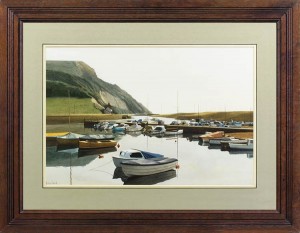MENU
- SELECT LANGUAGE
Coastal landscape paintings for Sale
Coastal landscape paintings may seem a rather specialist genre of landscape; this is just a convenient way to describe a ubiquitous subject, beloved by artists, in which the subject is part seascape and part true landscape painting. It is, of course, a common form on an island like Britain or Ireland, but became equally popular amongst the 19th and 20th century plein air painters who flocked to Brittany and Normandy, the beaches and harbours of the Netherlands and Belgium, and the coasts of Scandinavia.
It is a far older genre than this however; a Roman mural in the British Museum shows a boat departing from a harbour, on which is a bridge and a small villa with a belvedere. The harbour is peopled: a man waves farewell to the boat, and another fishes from the bridge. This scene dates from 1st century AD, and comes from a villa on the Bay of Naples, near to Pompeii; it’s by no means the only coastal landscape in Roman wall art. Later on, the 17th century saw the golden, classicizing harbours and seashores of Claude Lorrain, as well as Dutch scenes in a more realist vein – beaches, quays, shipping lanes outside small ports, and views of the sea from the open country.
Coastal landscapes offered a varied approach compared with either pure seascape or landscape; they could combine the sea with a more interesting horizon than a flat line; they might provide more exciting effects of climate and weather; they were often peopled, or could include animals; they set buildings against ships, or angry waves against tossing trees. There was also probably a pragmatic content to this genre, or sub-genre: it was easier and cheaper to paint the sea from an accessible seashore than to venture out onto the sea itself. Mark Mitchell’s collection includes a group of coastal paintings from several countries, varying from country scenes with a distant glimpse of the sea to full-scale seascapes, painted from a beach.


